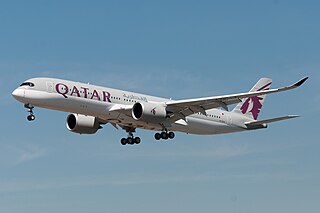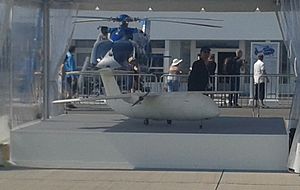
The Airbus A320 family are narrow-body airliners designed and produced by Airbus. The A320 was launched in March 1984, first flew on 22 February 1987, and was introduced in April 1988 by Air France. The first member of the family was followed by the longer A321, the shorter A319, and the even shorter A318 . Final assembly takes place in Toulouse in France; Hamburg in Germany; Tianjin in China since 2009; and in Mobile, Alabama in the United States since April 2016.

The Airbus A340 is a long-range, wide-body commercial passenger jet airliner that was developed and produced by the European aerospace company Airbus. In the mid-1970s, Airbus conceived several derivatives of the A300, its first airliner, and developed the A340 quadjet in parallel with the A330 twinjet. In June 1987, Airbus launched both designs with their first orders and the A340-300 took its maiden flight on 25 October 1991. It was certified along the A340-200 on 22 December 1992 and both versions entered service in March 1993 with launch customers Lufthansa and Air France. The larger A340-500/600 were launched on 8 December 1997, the A340-600 flew for the first time on 23 April 2001 and entered service on 1 August 2002.

The Airbus A330 is a wide-body airliner made by Airbus. In the mid-1970s, Airbus conceived several derivatives of the A300, its first airliner, and developed the A330 twinjet in parallel with the A340 quadjet. In June 1987, Airbus launched both designs with their first orders. The A330-300, the first variant, took its maiden flight in November 1992 and entered service with Air Inter in January 1994. The slightly shorter A330-200 variant followed in 1998. In 2014, Airbus launched the A330neo, re-engined with Trent 7000 turbofans, which entered service in November 2018.

The Airbus A380 is the world's largest passenger airliner, a wide-body aircraft manufactured by Airbus. Airbus studies started in 1988 and the project was announced in 1990 to challenge the dominance of the Boeing 747 in the long haul market. The A3XX project was presented in 1994; Airbus launched the €9.5 billion ($10.7 billion) A380 programme on 19 December 2000. The first prototype was unveiled in Toulouse on 18 January 2005, with its first flight on 27 April 2005. Difficulties in electrical wiring caused a two-year delay and the development cost ballooned to €18 billion. It obtained its EASA and FAA type certificates on 12 December 2006.

A wide-body aircraft, also known as a twin-aisle aircraft, is a jet airliner with a fuselage wide enough to accommodate two passenger aisles with seven or more seats abreast. The typical fuselage diameter is 5 to 6 m. In the typical wide-body economy cabin, passengers are seated seven to ten abreast, allowing a total capacity of 200 to 850 passengers. The largest wide-body aircraft are over 6 m (20 ft) wide, and can accommodate up to eleven passengers abreast in high-density configurations.

The Boeing 787 Dreamliner is an American long-haul, mid-size wide-body, twin-engine jet airliner manufactured by Boeing Commercial Airplanes. Its variants seat 242 to 330 passengers in typical two-class seating configurations. It is the first airliner with an airframe constructed primarily of composite materials. The 787 was designed to be 20% more fuel-efficient than the Boeing 767, which it was intended to replace. The 787 Dreamliner's distinguishing features include mostly electrical flight systems, raked wingtips, and noise-reducing chevrons on its engine nacelles.

The Airbus A400M Atlas is a European, four-engine turboprop military transport aircraft. It was designed by Airbus Military as a tactical airlifter with strategic capabilities to replace older transport aircraft, such as the Transall C-160 and the Lockheed C-130 Hercules. The A400M is positioned, in terms of size, between the C-130 and the C-17; it can carry heavier loads than the C-130 and is able to use rough landing strips. Along with the transport role, the A400M can perform aerial refuelling and medical evacuation when fitted with appropriate equipment.

The Airbus A350 XWB is a family of long-range, wide-body airliners developed by Airbus. The first A350 design proposed by Airbus in 2004, in response to the Boeing 787 Dreamliner, would have been a development of the A330 with composite wings and new engines. As market support was inadequate, in 2006 Airbus switched to a clean-sheet "XWB" design, powered by Rolls-Royce Trent XWB turbofan engines. The prototype first flew on 14 June 2013 from Toulouse in France. Type certification from the European Aviation Safety Agency (EASA) was received in September 2014 and certification from the Federal Aviation Administration (FAA) two months later.

The Airbus A220 is a family of narrow-body, twin-engine, medium-range jet airliners. The airliner was designed by Bombardier Aerospace and originally marketed as the Bombardier CSeries. Bombardier sold the CSeries airliner program to Airbus and it is now marketed by Airbus Canada Limited Partnership, a joint venture between Airbus and the Quebec government's investment arm Investissement Québec.

The Boeing 747-8 is a wide-body jet airliner developed by Boeing Commercial Airplanes. It was officially announced in 2005. The 747-8 is the third generation of the 747, with a lengthened fuselage, redesigned wings, new engines, and improved efficiency. The 747-8 is the largest 747 version, the largest commercial aircraft built in the United States, and the longest currently operational passenger aircraft in the world.

The Boeing A160 Hummingbird is an unmanned aerial vehicle (UAV) helicopter. Its design incorporates many new technologies never before used in helicopters, allowing for greater endurance and altitude than any helicopter currently in operation.

An electric aircraft is an aircraft powered by electric motors. Electricity may be supplied by a variety of methods including batteries, ground power cables, solar cells, ultracapacitors, fuel cells and power beaming.

The Airbus Zephyr is a series of lightweight solar-powered UAV.

The Boeing AH-6 is a series of light helicopter gunships based on the MH-6 Little Bird and MD 500 family. Developed by Boeing Rotorcraft Systems, these include the Unmanned Little Bird (ULB) demonstrator, the A/MH-6X Mission Enhanced Little Bird (MELB), and the proposed AH-6I and AH-6S.

The Comac C919 is a narrow-body twinjet airliner developed by Chinese aerospace manufacturer Comac. The development programme was launched in 2008, production of the prototype began in December 2011, it rolled out on 2 November 2015 and the aircraft's maiden flight was on 5 May 2017. Its first commercial deliveries are expected in 2021 to China Eastern Airlines. The aircraft, primarily constructed with aluminium alloys, is to be powered by either CFM International LEAP or ACAE CJ-1000A turbofan engines, and be able to carry 156 to 168 passengers in a normal operating configuration up to 5,555 km . It is intended to compete primarily with the Boeing 737 MAX and Airbus A320neo. As of 31 August 2018, Comac has 1008 commitments including 305 firm orders, mostly from Chinese leasing companies or airlines.

Airbus SE is a European multinational aerospace corporation. In 2019, Airbus was the world's largest airliner manufacturer and took the most airliner orders. Airbus is registered in the Netherlands; its shares are traded in France, Germany and Spain. It designs, manufactures and sells civil and military aerospace products worldwide and manufactures aircraft in the European Union and various other countries. The company has three divisions: Commercial Aircraft, Defence and Space, and Helicopters, the third being the largest in its industry in terms of revenues and turbine helicopter deliveries.
Airbus Defence and Space is a division of Airbus responsible for defence and aerospace products and services. The division was formed in January 2014 during the corporate restructuring of European Aeronautic Defence and Space (EADS), and comprises the former Airbus Military, Astrium, and Cassidian divisions. It is the world's second largest space company after Boeing and one of the top ten defence companies in the world.

The Airbus A330neo is a wide-body jet airliner developed by Airbus from the Airbus A330. A new version with modern engines comparable to those developed for the Boeing 787 was called for by owners of the current A330. It was launched on 14 July 2014 at the Farnborough Airshow, promising 14% better fuel economy per seat. It exclusively uses the larger Rolls-Royce Trent 7000. Its two versions are based on the A330-200 and -300: the -800 has a range of 8,150 nmi (15,090 km) with 257 passengers while the -900 covers 7,200 nmi (13,330 km) with 287 passengers. The -900 made its maiden flight on 19 October 2017 and received its EASA type certificate on 26 September 2018. It was first delivered to TAP Air Portugal on 26 November and had its maiden commercial flight on 15 December. The -800 made its first flight on 6 November 2018 and received EASA type certification on 13 February 2020.

The Airbus CityAirbus is a multinational project by Airbus Helicopters to produce an electrically-powered VTOL personal air vehicle demonstrator. It is intended for the air taxi role, to avoid ground traffic congestion.
The On-Demand Small Unmanned Aircraft System (ODSUAS) is a custom-tailored, miniature 3D printed drone created by the U.S. Army Research Laboratory (ARL) and Georgia Technical Institute’s Aerospace Systems Design Laboratory. It was designed to provide flexible unmanned aircraft vehicle (UAV) support, where soldiers can input the specific requirements they need, such as size, weight, and endurance, into the mission-planning software before the drone is configured and 3D printed within 24 hours. The process allows the manufacturing of additional drone parts as needed, eliminating the need to carry spare parts for different configurations. While a 3D printer constructs the body of the UAV, the motors, sensors, cameras, propellers, and other apparatus would have to be obtained from a standing inventory.


















